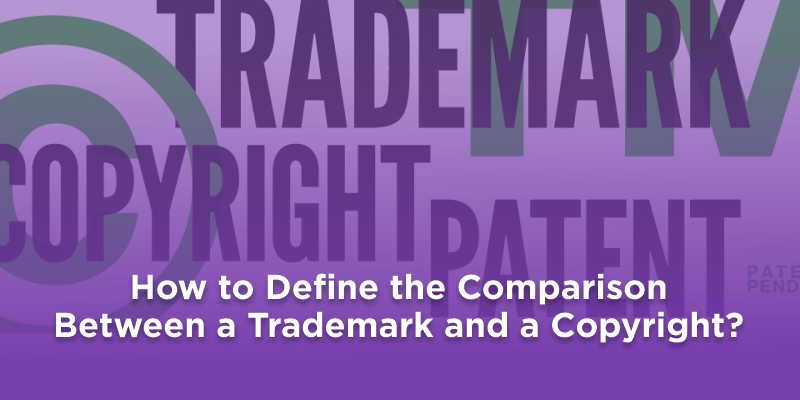How to Define the Comparison Between a Trademark and Copyright?

Introduction
In todays’ age of highly competitive market place it has become imperative for everyone establish their brand in the target market. To establish your brand in the market, you must provide authenticate goods and services when you are doing your business across the country or globally. Brand awareness and brand recognition requires a lifetime of hard work, time and patience. Your brand awareness leads to loyal customer base. Thus, once you have established yourself in the market, it becomes the most important task for any brand to protect themselves from duplications and misuse. To protect your brand there are several legislative acts implemented by government in order to provide protection to the original and authentic brand. There is trademarks act, copyright acts, patents act which can protect your brand as well as your innovations, designs and any artistic creation. Now, you must know the cat in which you can get your brand protected. So here in this article we will focus on basically two acts i.e. Trademark and copyright act. This article mainly focuses on the comparison between trademark and copyright.
Trademarks
Trademark act provides protection to your brand once you register it under the act. So what can be registered as trademark under the trademarks act?
Name
You can register a product name, business name, name of any individual or surnames. However, such a name must not be used for business, trading, or services. It can be in any specific text, colour, and style and most importantly it must be unique and distinctive.
Product name
The companies who are manufacturing or trading multiple goods or services register their products for trademarks for example the company Hindustan Unilever have registered “DOVE”, “SUNSILK” , “VIM”, “LIPTON” and many more.
Business name
You can register the name of your business or your company. For example, “PARLE “,”RELIANCE” All of these are trademarked business names.
Name of a person
A trademark can be used to protect the name of a person if they earn money through it. Most of the times, this trademarks are done by celebrities who are public figure and their name only is their brand. Examples: “SACHIN TENDULKAR”, “VIRAT KOHLI”, and “M S DHONI”. They have registered their names.
Surnames
India is a country where the business was originally run by the surnames. Trademark can be taken for surnames which are used to carry on business. For example “TATA”, “Mahindra”, “BAJAJ”. However, Ministry doesn’t allow trademarks to be placed on common surnames like “Kapoor” or “Shah”.
Abbreviations or Numbers as a Trademark
You can register trademark for letters, abbreviations, or any combination thereof which are used for business and which are able to distinguish the goods or services offered by one person from another’s. For example “IBM”, “BMW”, “I10, “i20”.
Logo or symbols
If you have a particular logo for your brand or product or service, then you can trademark it under the trademarks act. This trademark is known as “Device mark”. It must be unique. Symbols have their own identity and own popularity. Many brands are just known by their unique symbols.
Tag line
Now a days every business have their own tagline which describes their mentality, their purpose and their ambitions behind their goods or services. Tagline or slogan adds value to the business. For example, “Growth is life” this is tagline of reliance. McDonald’s’s slogan is “I’m enjoying it.”
Sound mark
A sound track articulated by musical notes can be registered as trademark. It must be distinctive and original. Yahoo!’s Yodel was the first Indian sound mark. Other sound marks include tunes from Intel or Nokia, Britannia’s 4-bell sound, and others.
Scent mark
It is very difficult to articulate scent or smell as trademark. But you can trademark the smell by representing its chemical formulae. The original owner must fulfil the criteria or requirement to be registered as scent trademark.
Motion mark
Motion mark means any design which is moving in nature. Most of the motion marks moves for around 5-6 seconds. It is important to represent the images of the movement of these marks in sequence. The best example of a motion mark is the logo of Microsoft, logo of McDonald’s “M”, “Star Plus”, and “Master Card”.
Shapes
The unique shape of your product can be registered as trademark. The shape of goods to be trademarked must not be the natural shape of any goods. The 3D i.e. you can trademark 3-dimensional products as well. For example, the shape of coco-cola bottle, the shape of “Toblerone” chocolate.
Packaging
The label or packaging of a product can also be registered as trademark under the Trademark Act. Many products are known for their unique packaging style and mostly identified by their packaging. In such cases, you can also register your packaging as trademark It must contain a unique design, colour which gives a new identity to the product. The label or purple coloured packaging of the Dairy Milk is a registered trademark.
Now, let us see what can be registered as copyright.
What can be registered as copyright?
Usually the copyright act protects which is original in nature such as works done under literature, music, art, photography, cinema/film or even a computer programme. If we go in details the copyright protects lyrics to a song, tunes, pictures, graphics, sculpture, piece of architecture, sound recordings, drama, choreographed works, parodies, signatures, computer programmes. The examiner of copyright have to study in deep to verify whether such work is original in nature or if some work have been copied from its original inventor or an artist. To see the intricate details, you must examine each of these images in greater detail. It is the responsibility of the applicant to prove that he/she is the original inventor or original artist of the product to be copyright and it is not copied from anywhere. One also must know that what are those things which are not protected by copyright act?
Such things which cannot be protected by copyright includes speech/performance that has not been written or recorded which means that only those works which are on records can only be copyrighted. Titles, names, and short phrases are all examples of works; symbols or designs that are well-known to others are also included. Basic typographic finery, lettering, and use of coloring techniques. Lists of ingredients any kind of Ideas, systems, methods processes as distinguished from the said description, explanation, or an illustration. Moreover, general facts and figures that are generic property and which is available on public domain cannot be registered for copyright. These may include, standard calendars, charts of height/weight, information from public documents, and so on.
Conclusion
Once you finalise that which act is more preferable for you to register your product in, you may proceed to register the trademark or copyright. Copyright registration and trademark registration both can be handled by our expert penal at onlinechartered.com.
